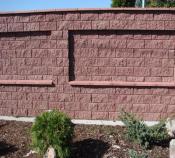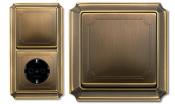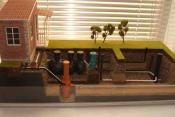Search
Login
We install the posts for the fence with our own hands, the types of posts for the fence, how to install the posts for the fence
The times when the fence performed only a protective function are long gone. Today it is an integral element of landscape design. After all, your guest always sees your fence first, and then the yard and house
Table of contents
Fencing Methods
So how to choose a fence for the house and not make a mistake? First of all, it should be noted that all fences are divided into two main types:
lungs;

heavy.

Light fences do not require pouring the foundation tape; pillars are simply buried in the ground below the freezing level.
These include:
- corrugated fences on metal poles;
- picket;
- mesh fence;
- fences made of plastic;
- plexiglass fences.
Heavy fences require the arrangement of the foundation and the fence tape itself.
These include:
- concrete fences;
- brick or stone fences;
- corrugated fences with brick pillars.
Types of fence posts
Each owner wants to make his fence not like the neighbors, to give him personality. Let's look at which pillars for the fence can be used.
Wooden posts they are used in front gardens, small wooden hedges, it is not recommended to use them for the construction of a full-fledged fence due to the short service life of up to 10 years. Poles must be primed with antiseptics and coated with drying oil for water-repellents, then can be painted in any color.

Asbestos-cement pipes they are used very rarely, mainly for fences in which the fence is a chain link. The complexity of mounting other fasteners does not contribute to their distribution. If you do not install an umbrella on top for such a pipe, it turns into a well and rainwater, freezing in the winter, will simply break such a pipe.

Concrete pillars rarely used, the price of factory stepsons is large and repels buyers. Stepsons are durable and practical to use, but as with asbestos-cement pipes, there are problems with fastening.

Pillars made of metal pipes the most popular and cheapest material for building fencing. Service lines are measured for decades, are unpretentious in operation, easy to install, weld the frame or weld the mount on the shoulder to even an unexperienced welder. A large assortment of metal pipes will satisfy various customer requests. Round, rectangular, square as your heart desires.

Piles on Screw Piles modern method of installing fence posts. Using special equipment, up to 40 poles are screwed in a day, which is 120 meters of the fence, a very convenient method to use.

How to install do-it-yourself fence posts
Pillars selected, plot marked, can be installed! But what installation method to choose so that the pole does not lead and the fence does not squint next year. First of all, you need to determine what soil you have on the site.
Soils are conditionally divided into two types:
heaving;
non-porous.
Paddy soils are those that, when water freezes in them, increase their volume. These include small and dusty, sandy loam, clay and loam. Non-porous rocky and sandy soils (coarse sand).
Understood the ground, now what installation method to choose?
We dig or drill holes to a shallow depth and pour concrete with the universal method that almost all of us have encountered. But is he so good? If your soil is not porous, then the columns will stand evenly and beautifully for many years. This method is not suitable for installation on heaving soils. He (the ground) does not care what to push out of himself just a column or column with concrete.
Often we are advised to drill a hole below the freezing depth of the soil and make an extension there to increase the column area, then the heaving force will not be able to stretch or skew the column. This method works, it works well, but it is too costly to equip an inexpensive fence. It contains a lot of unnecessary operations for excavating and mixing concrete.
But there is a way that at times saves the builder’s time and money. If your soil is not porous, then you don’t need to do anything, but if heaving then you need to replace it with non-porous.
On non-porous soil, holes for poles can be drilled to the size of a column and no additional fortifications need to be tied.
For heaving soil, the hole is drilled more than the diameter of the column and below the depth of freezing of the soil. Depending on the depth, the hole is covered with small gravel, so that at least 60 cm remains to the surface of the earth. In this case, gravel should be well tamped. Next, install your column and ram it with rubble. So we replaced the heaving soil with non-porous! Thanks to the drainage from crushed stone, water calmly goes into the ground (remember the depth of the hole below the freezing level). We did not interfere with concrete and saved on cement, as well as on the length of each column.
If you put a heavy fence with a foundation tape and brick or stone pillars, you need to remember about quality drainage. Under the foundation tape, you need to make a sand cushion and, if possible, also replace the heaving soil with non-heaving soil to make sand and sand. Then the soil will not freeze to the foundation of the tape. And the forces of frost heaving are practically not acting on it. Indeed, the durability of your building will depend on the arrangement of drainage. It should be remembered that the strength of frost heaving is up to 7 tons / m2.





